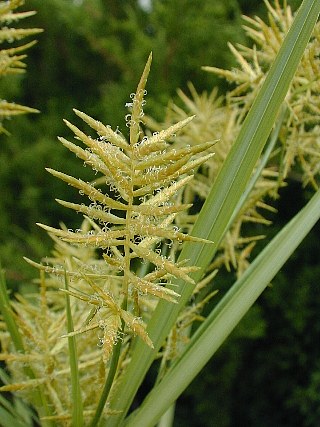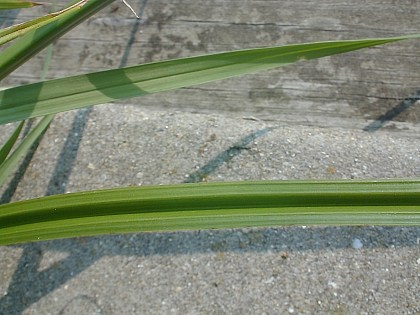Description:
This
perennial sedge is ½–2' tall and unbranched. The central stem is
erect, 3-angled, and mostly covered by the sheaths of the leaves. The
leaves tend to congregate toward the base of the plant. The leaf blades
are up to 1½' long and 1/3" (8 mm.) across; they are light green and
glabrous,
spreading outward from the stem. There is a conspicuous channel along
the central vein of each leaf blade, especially the larger ones. The
leaf sheaths are whitish green, closed, and hairless; sometimes they
become pale red toward the base of the plant. The central stem
terminates in an umbel or compound umbel of floral
spikes; the size and
shape of the umbel is rather variable (on larger plants, it is usually
several inches across). Each umbel has 1-3 sessile spikes and 6-10
non-sessile spikes on straight branches of varying length. At the base
of each umbel
or compound umbel of spikelets, there are several leafy bracts of
varying length; the largest bract is usually longer than the
inflorescence. Each floral spike is about 2-3" long, consisting of 4
ranks of spikelets along its central stalk (or rachis). The central
stalk is flattened and narrowly winged. The spikelets are perpendicular
to this stalk and about ½–¾" long. The spikelets are yellow to golden
brown, narrowly linear, and flattened in shape; they consist of 10-30
florets and their scales. The overlapping scales are appressed or
slightly spreading along the length of each spikelet; each scale is
2.0–3.0 mm. in length. Each floret has a white tripartite style and
yellowish brown anthers; the tips of the styles are curly. The blooming
period occurs from mid-summer to early fall. Pollination is by wind.
The florets are replaced by small achenes that are 1.0–1.5 mm. long,
oblongoid or oblongoid-obovoid, and flattened. The shallow root system
is fibrous, rhizomatous, and tuberous. The white rhizomes have a
slightly segmented appearance from the brown margins of their outer
membranes; the rhizomes are connected to small globoid tubers up to ½"
across. Young tubers are white, while older tubers are covered by a
brown outer membrane; they are usually found within 6" of the ground
surface. Vegetative colonies of plants are often produced from the
tubers and their rhizomes.
compound umbel of floral
spikes; the size and
shape of the umbel is rather variable (on larger plants, it is usually
several inches across). Each umbel has 1-3 sessile spikes and 6-10
non-sessile spikes on straight branches of varying length. At the base
of each umbel
or compound umbel of spikelets, there are several leafy bracts of
varying length; the largest bract is usually longer than the
inflorescence. Each floral spike is about 2-3" long, consisting of 4
ranks of spikelets along its central stalk (or rachis). The central
stalk is flattened and narrowly winged. The spikelets are perpendicular
to this stalk and about ½–¾" long. The spikelets are yellow to golden
brown, narrowly linear, and flattened in shape; they consist of 10-30
florets and their scales. The overlapping scales are appressed or
slightly spreading along the length of each spikelet; each scale is
2.0–3.0 mm. in length. Each floret has a white tripartite style and
yellowish brown anthers; the tips of the styles are curly. The blooming
period occurs from mid-summer to early fall. Pollination is by wind.
The florets are replaced by small achenes that are 1.0–1.5 mm. long,
oblongoid or oblongoid-obovoid, and flattened. The shallow root system
is fibrous, rhizomatous, and tuberous. The white rhizomes have a
slightly segmented appearance from the brown margins of their outer
membranes; the rhizomes are connected to small globoid tubers up to ½"
across. Young tubers are white, while older tubers are covered by a
brown outer membrane; they are usually found within 6" of the ground
surface. Vegetative colonies of plants are often produced from the
tubers and their rhizomes.
Cultivation:
The
preference is full or partial sun, wet to mesic conditions, and a
friable soil containing fertile loam, silt, or sand. This sedge can
spread aggressively where the ground is bare and moist. It can inhibit
the growth of other plants by depleting the soil of nitrogen.
Vegetative growth occurs primarily during the warm weather of summer
because of the C4 metabolism of this species. Temporary flooding is
tolerated.
Range & Habitat:
Yellow Nut Sedge occurs in every county of Illinois and it is quite
common
(see Distribution
Map). This sedge is native to both North America and South
America,
as well as Eurasia and Africa. Habitats include prairie swales, swales
in open woodlands, sedge meadows, edges of ponds, sand flats and mud
flats in wetlands, gardens and lawns, poorly drained areas of fields,
ditches, and waste areas. Disturbed moist areas are preferred.
Faunal Associations:
The caterpillars of the moth Diploschizia impigritella
bore into the stems and leaf sheaths of Yellow Nut Sedge. Its spikelets
and tubers are eaten by the Canada Goose and various dabbling ducks,
including the Northern Pintail, Green-Winged Teal, Blue-Winged Teal,
and Mallard. The Canada Goose also feeds on the foliage of Yellow Nut
Sedge. Its foliage is also edible to cattle and other mammalian
herbivores, while pigs and squirrels have been known to eat the tubers.

Photographic
Location:
The photographs were taken of plants growing in a lawn at Urbana,
Illinois, and at a flower garden in
Crystal Lake Park of the same city.
Comments:
Yellow Nut Sedge is quite attractive, but rather aggressive, as the
small tubers can persist in the ground even when a plant is pulled out
by its roots. This is the most common Cyperus sp.
(Flat Sedge) in Illinois. Yellow Nut Sedge has a similar appearance to Cyperus
strigosus (Straw-Colored Flat Sedge) and Cyperus
erythrorhizos (Red-Rooted Flat Sedge). The root systems of
the latter two species lack tubers and their rhizomes, if present, are
without membranous segments as described above. The spikelets of
Straw-Colored Flat Sedge have longer scales (3.5–5.0 mm. in length),
while the spikelets of Red-Rooted Flat Sedge have shorter scales
(1.0–1.5 mm. in length), than those of Yellow Nut Sedge. Another
similar species, Cyperus odoratus (Rusty Flat
Sedge), has reddish or golden brown scales that are the same length as
those of Yellow Nut Sedge; however, it is a summer annual that has
neither rhizomes nor tubers.